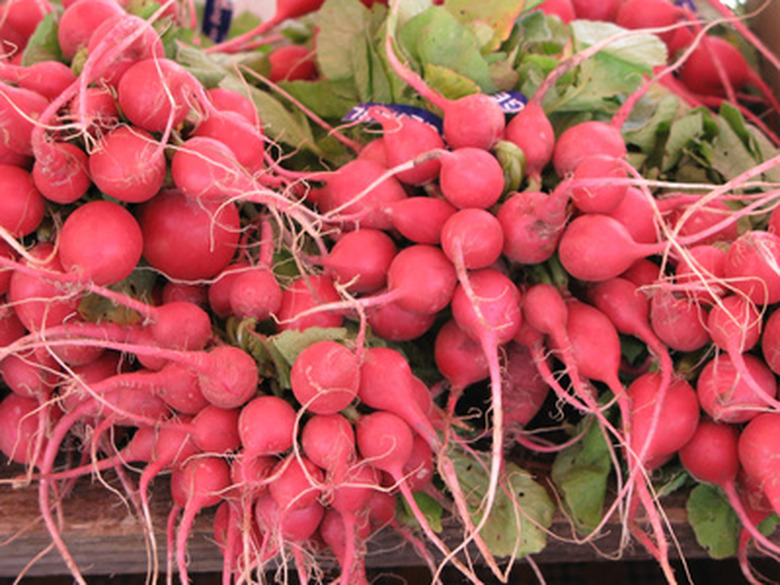The Effect Of Fertilizers On Radish Growth
Step 1
Very few soils supply nutrients in the quantities needed for optimum growth of vegetables. Supplementation with artificial or organic fertilizers allows the gardener to fine tune the amounts to the needs of each type of plant. Leafy vegetables, for instance, need more nitrogen than those grown for their fruits or roots.
Nitrogen
Step 1
Nitrogen promotes green leafy growth and, though the atmosphere is 78 percent nitrogen, plants cannot use this source directly. Microorganisms transform gaseous nitrogen into forms that plants can use during the process of decay. These forms are soluble and can be quickly leached out of the soil. When plants need nitrogen they grow small, yellowish or discolored leaves and weak stems. Applications of a high-nitrogen fertilizer such as fish emulsion will give you lots of beautiful leaves in a short period of time, but your radish roots may be small or lacking altogether. Use a low nitrogen fertilizer but don't omit it entirely.
Step 2
- Very few soils supply nutrients in the quantities needed for optimum growth of vegetables.
- Nitrogen promotes green leafy growth and, though the atmosphere is 78 percent nitrogen, plants cannot use this source directly.
Phosphorus
Step 1
Phosphorus is vital for seed germination, root growth and the setting of fruits and seeds. A deficiency can show up as stunted growth with a purplish tinge to the leaves. It does not leach easily, so stays in the soil for two to three years after application. As root vegetables, radishes can benefit from fertilizers such as bone meal that are high in phosphorus. Bone meal also contains calcium, another nutrient that enhances root growth.
Potassium
Step 1
Plants use potassium to build starches and sugars so it also contributes to the growth of good-sized roots as well as disease resistance and the development of flowers and fruits. Easily scorched leaves may indicate a deficiency. Since potassium is so useful for producing large roots it should be applied generously to the quick developing radishes, usually in the form of a 5-10-10 fertilizer — 5 percent nitrogen, 10 percent phosphorus and 10 percent potassium.
Step 2
- Phosphorus is vital for seed germination, root growth and the setting of fruits and seeds.
- Plants use potassium to build starches and sugars so it also contributes to the growth of good-sized roots as well as disease resistance and the development of flowers and fruits.
Micronutrients
Step 1
Most soils supply enough micronutrients, the minerals that are essential for plant growth but needed in only tiny quantities. Generous applications of compost will not only improve your soil but will also supply many of these nutrients. Seaweed extract is also a good source of minerals. If your radish crops are poor, you may have a deficiency of one or more micronutrients. Lack of boron causes cracking of the skin, lack of calcium causes a cupping of the leaves, and magnesium and manganese deficiencies cause yellowing or bronzing of leaves between the veins.
